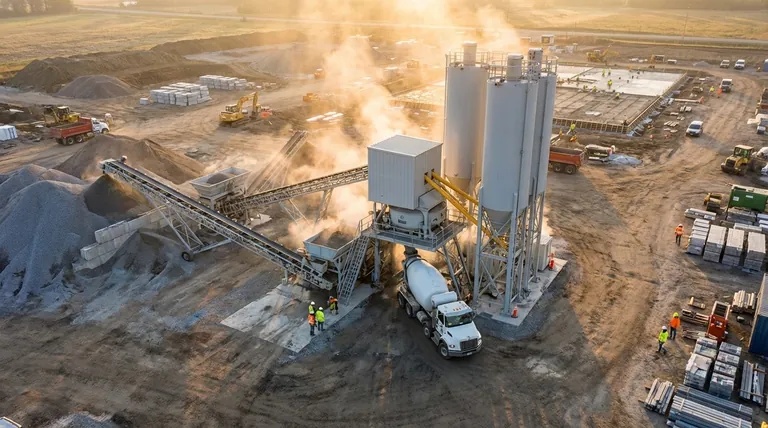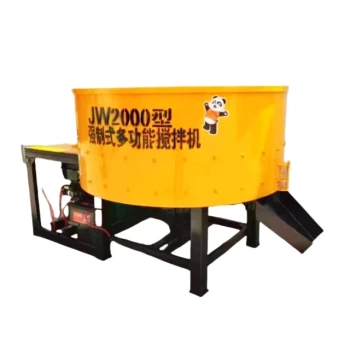While incredibly convenient, Ready-Mix Concrete (RMC) introduces significant limitations centered on time, cost, and a dependency on supplier quality. The primary drawbacks are the extremely short window for placing the concrete upon delivery, the potential for high costs associated with logistics and minimum orders, and the fact that the final quality of your project is entirely reliant on the supplier's expertise and equipment.
The decision to use Ready-Mix Concrete is fundamentally a trade-off. You gain the convenience of a pre-formulated, high-volume product but surrender direct control over the mix quality and become subject to strict logistical and time-based constraints.

The Core Challenge: Time and Logistics
Using RMC means you are racing against a chemical reaction that cannot be stopped. The entire success of the pour depends on flawless coordination from the plant to the final placement.
The Perishable Nature of Concrete
From the moment water is added to the cement at the batching plant, the hydration process begins. This chemical reaction, which gives concrete its strength, is irreversible and time-sensitive. The concrete has a limited workable life, typically around 90 minutes, before it starts to set.
Travel Time and Site Accessibility
This strict time limit makes RMC vulnerable to external factors. Traffic delays, distance from the plant to the job site, and poor site accessibility can turn a perfectly good batch of concrete into unusable waste. The delivery truck must be able to reach the pour location without impediment.
The Risk of On-Site Delays
Any delay on the construction site can be catastrophic. If the formwork isn't ready or the crew is unprepared, the concrete-filled truck has no choice but to wait. This not only risks the batch hardening in the truck but also often incurs significant waiting-time fees from the supplier.
The Factor of External Dependency
When you choose RMC, you are outsourcing one of the most critical components of your structure. Your project's success is now in the hands of a third-party supplier.
Quality is Outsourced
The strength, durability, and finish of your concrete depend entirely on the supplier's mix design, the quality of their aggregates, and the precision of their batching equipment. Any errors in the water-to-cement ratio or aggregate composition are made off-site, beyond your immediate control.
The Need for Rigorous Vetting
This dependency makes supplier selection a crucial step. You are not just buying a commodity; you are hiring a critical partner. Verifying their certifications, track record, and quality control procedures is essential to mitigate the risk of receiving an inferior product.
Understanding the Trade-offs and Costs
While RMC can be efficient for large projects, its cost structure and logistical model present notable trade-offs that must be carefully considered.
Initial and Hidden Costs
The price of RMC includes the material, the labor at the plant, and transportation. For very large pours, this is efficient. However, suppliers often have minimum order quantities, making RMC a very expensive option for small projects or repairs. Furthermore, fees for weekend delivery or for truck waiting times can quickly escalate costs.
Setting Up a Batching Plant
For very large or remote projects, the alternative is an on-site batching plant. While this provides maximum control, the initial capital investment for the equipment and the required space can be prohibitively expensive, representing a significant limitation in itself.
Making the Right Choice for Your Project
Evaluating these limitations against your project's specific needs is the key to a successful outcome.
- If your primary focus is a large-scale, high-volume pour: RMC is often the only practical choice, but meticulous logistical planning and thorough supplier vetting are non-negotiable.
- If your primary focus is a small repair or a remote site: On-site mixing often provides greater flexibility, avoids minimum order fees, and can be far more cost-effective.
- If your primary focus is absolute quality control: The only way to achieve complete control is with an on-site batching plant, but this is only feasible for the largest and most technically demanding projects.
Ultimately, understanding these limitations empowers you to manage the risks associated with an otherwise invaluable construction material.
Summary Table:
| Limitation | Key Challenge | Impact on Project |
|---|---|---|
| Time & Logistics | Strict 90-minute workable life; vulnerable to traffic and site delays. | Risk of wasted batches and project delays. |
| External Dependency | Quality control is outsourced to the supplier; requires rigorous vetting. | Final structural integrity depends on third-party expertise. |
| Cost & Trade-offs | Minimum order quantities; hidden fees for waiting time or weekend delivery. | Can be expensive for small projects; cost escalation potential. |
Need a reliable concrete solution with greater control? At GARLWAY, we specialize in construction machinery like concrete mixers and batching plants, empowering construction companies and contractors globally to produce high-quality concrete on-site. Avoid the limitations of RMC by taking control of your mix, schedule, and budget. Contact our experts today to find the perfect equipment for your project's scale and requirements.
Visual Guide

Related Products
- HZS180 Ready Mix Concrete Plant for Foundations with Sand and Cement
- HZS120 Ready Mix Concrete Batching Plant Commercial Mud Cement Mixer
- Portable Ready Mix Concrete Mixer Equipment
- Portable Concrete Mixer Machine Equipment for Mixing Concrete
- HZS75 Concrete Batching Plant Cement Mixer Price Concrete Mixer Bunnings Mixing Plant
People Also Ask
- What are the disadvantages of ready mixed concrete? Navigate Logistical & Cost Risks
- What are the advantages of ready mix concrete? Higher Quality, Efficiency & Cost Savings
- How to make ready mix concrete stronger? Boost Strength with Proven Mixing Techniques
- How does ready-mix work? A Guide to Efficient, High-Quality Concrete Delivery
- What are the advantages of a concrete plant? Achieve Consistent Quality & Efficiency for Large-Scale Projects



















